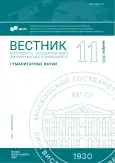THE CONCEPT OF “MAN” IN THE SPANISH LEXICOGRAPHY OF THE XVII-XVIII CENTURIES
- Authors: Fedosova O.V.1, Ishchenko A.D.1
-
Affiliations:
- Moscow State Linguistic University
- Issue: No 11(892) (2024)
- Pages: 112-119
- Section: Linguistics
- URL: https://journal-vniispk.ru/2542-2197/article/view/292026
- ID: 292026
Cite item
Full Text
Abstract
The purpose of the article is to consider the content and evolution of the concept of “man” in the Spanish national picture of the world, represented in the Castilian language of the XVII-XVIII centuries. The Spanish dictionaries of the XVII-XVIII centuries served as the research material. Based on the method of analyzing semantic fields, the method of component analysis, logical-semantic, diachronic methods and the method of cultural and historical analysis, the authors managed to establish the scope and content of the concept of “man” in the Spanish lexicography of the selected period, as well as to trace its transformation during the development of the Spanish language.
About the authors
Oksana Vitalievna Fedosova
Moscow State Linguistic University
Author for correspondence.
Email: fedossova@yandex.ru
Doctor of Philology (Dr. habil.), Associate Professor, Professor at the Department of the Spanish Language and Translation Moscow State Linguistic University
Russian FederationAlexandra Dmitrievna Ishchenko
Moscow State Linguistic University
Email: alexandra.i1097@gmail.com
Lecturer at the Department of Spanish and Translation Moscow State Linguistic University
Russian FederationReferences
- Brinyuk, E. V. (2020). Representation of concept of «human» in creolized educational texts for learners of Russian as a foreign language. The Upper Volga Philological Bulletin, 1(20), 73–79. 10.20323/2499-9679-2020-1-20-73-79. (In Russ.)
- Medvedev, V. A. (2011). Koncept cheloveka v istorii evropejskoj filosofii i kul’tury = The concept of man in the history of European Philosophy and Culture. Scientific Yearbook of the Institute of Philosophy and Law of the Ural Branch of the Russian Academy of Sciences, 11, 23–39. (In Russ.)
- Sergeeva, E. V. (2013). Bog i chelovek v russkom religiozno-filosofskom diskurse = God and man in Russian religious and philosophical discourse: monograph. Moscow: Direkt-Media.
- Kul’kova, E. S. (2015). Rol’ semanticheskih oppozicij v formirovanii obraza soznaniya (na materiale analiza associativnogo polya “vozrast cheloveka”) = The role of semantic oppositions in the formation of the image of consciousness (based on the analysis of the associative field “human age”). Vestnik of Moscow State Linguistic University. Humanities, 20(731), 434–444. (In Russ.)
- Pepelyaeva, E. A., Soboleva, O. V. (2019). O Probleme vyyavleniya sostava i granic leksiko-tematicheskih grupp semanticheskogo polya “chelovek” (na materiale russkogo yazyka) = On the problem of identifying the composition and boundaries of lexical and thematic groups of the semantic field “man” (based on the material of the Russian language. Vestnik Rossijskogo novogo universiteta, 4, 79–85. (In Russ.)
- Tilloeva, S. M. (2016). Analiz leksicheskih edinic, vhodyashchih v leksiko-tematicheskuyu gruppu «vneshnij oblik cheloveka»: sopostavitel’nyj aspekt (na materiale russkogo, tadzhikskogo i persidskogo yazykov) = Analysis of lexical units included in the lexical-thematic group “human appearance”: a comparative aspect (based on the material of Russian, Tajik and Persian languages). Filologicheskie nauki. Voprosy teorii i praktiki, 3–1(57), 180–183. (In Russ.)
- Trier, H. (1931). Der deutche Wortschatz im Sinnbezirk des Verstandes. Heidelberg, 41(1), 100–397.
- Duchacek, O. (1978). L’évolution de l’articulation linguistique du domaine esthétique du latin au français contemporain. Brno: Univerzita J. E. Purkyně.
- Admoni, V. G. (1988). Grammaticheskij stroj kak sistema postroeniya i obshchaya teoriya grammatiki = Grammatical structure as a system of construction and general theory of grammar. Leningrad: Nauka. (In Russ.)
- Bondarko, A. V. (1984). Funkcional’naya grammatika = Functional grammar. Leningrad: Nauka. (In Russ.)
Supplementary files










